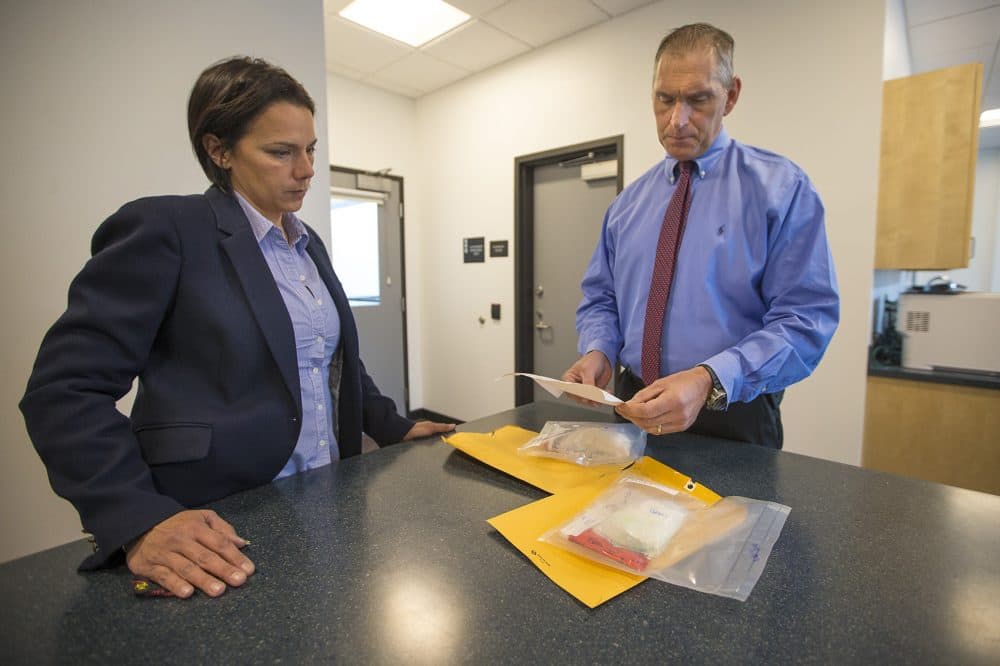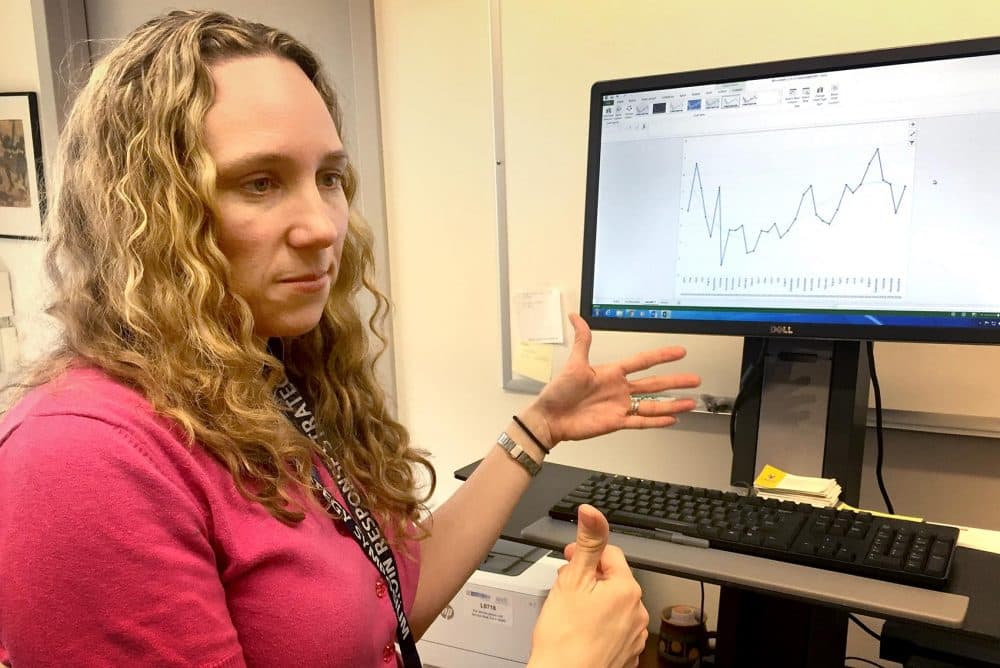Advertisement
Fentanyl-Laced Cocaine Could Be 'Next Wave' Of Opioid Crisis, Some Warn

A pipe was the only sign of drug use near Chris Bennett's body, in November. But it looked like the 32-year-old Taunton native had stopped breathing and died of an opioid overdose. Bennett's mother Liisa couldn't understand what happened. Then she saw the toxicology report.
"I'm convinced he was smoking cocaine that was laced," she says. "That's what he had in his system was cocaine and fentanyl."
Liisa Bennett was shocked. Chris had developed an addiction to pain pills and then heroin in his late teens but had not used opioids for at least 10 years, as far as his mom knew. She had warned her son that if he ever used opioids again he'd be in greater danger of an overdose because fentanyl, which is many times more powerful than heroin, was in much of the supply.
"My focus was making sure that he wasn't going to do the heroin that was laced," Bennett says, adding that she never suspected the crack cocaine Chris smoked occasionally would kill him. "Absolutely not."
Bennett's story echoes those heard on college campuses, where students are snorting cocaine to stay awake or during a campus party, and overdosing on fentanyl. Thirty-, 40- and 50-year-olds are celebrating their big birthday with a line of cocaine and keeling over. And regular cocaine users report feeling the expected rush and then falling asleep. If any of these men and women use cocaine alone or do not have the opioid reversal drug naloxone handy, some don't wake up.
Fentanyl-Laced Cocaine, By The Numbers
It’s not clear how many of the estimated 1,977 deaths listed as opioid overdoses last year in Massachusetts represent people who thought they were doing cocaine. The state doesn’t register drug combinations found in most bodies after an overdose.
Connecticut does. There, the number of deaths involving cocaine and fentanyl together has increased 420 percent in the last three years. (Heroin laced with fentanyl still claimed more lives in Connecticut during that same period.)
In Massachusetts, an increasing amount of cocaine laced with fentanyl is changing hands on the streets.
State police recorded 199 samples of cocaine laced with fentanyl last year, a nearly threefold increase from 2016 -- but still a small percentage of total cocaine seizures.
The Drug Enforcement Agency (DEA) says Massachusetts was one of the top three states for seizures of cocaine/fentanyl mixtures in 2015 and 2016, with one of the largest individual busts in Methuen.
Advertisement
Who's Adding Fentanyl To Cocaine, And Why?
The DEA's latest National Drug Threat Assessment says adding fentanyl to cocaine is typically for the purpose of "speedballing," which combines the rush of a stimulant, often cocaine, with a drug that depresses the nervous system, such as heroin. It's a dangerous combination in any form -- more so with fentanyl.
But there's speculation that something else is happening in the current surge of cocaine/fentanyl overdoses and deaths.
A dozen EMTs, police officers, physicians and outreach workers contacted for this story describe men and women who were revived after an opioid overdose and claimed they had only used cocaine. So when was fentanyl added and why?

Some researchers say fentanyl showing up in cocaine looks to be accidental, a product of messy packaging rather than malicious intent. Boston Medical Center epidemiologist Traci Green says the rise in cocaine/fentanyl deaths she's tracking out of Rhode Island is commensurate with the increase in fentanyl deaths overall.
"It's more of a contamination model rather than one that is malicious or purposeful," says Green, who is also an associate professor of emergency medicine and epidemiology at the Brown University School of Medicine.
But a growing number of law enforcement agents, doctors, recovery providers and drug users argue for malicious intent. They speculate that cartel leaders are using cocaine to expand the market of people addicted to opioids.
"People who were just using cocaine occasionally, now they’re using cocaine every day," says Rafael, who buys cocaine and other drugs, often several times a day, on the streets of Boston. (We've agreed to use just his first name.)
Rafael says dealers, high up, are intentionally adding fentanyl to cocaine because fentanyl is a more addictive drug.
"It’s all about making them [drug users] need the product," Rafael says.
There's at least one flaw in that market expansion theory, says Albie Park, who co-founded a drug use harm reduction program out of Northampton called HRH413.
"If you're opioid naive [with no tolerance for opioids] and you take fentanyl, there's a good chance you'll die," Park says. "So adding fentanyl to cocaine may just scare people away. "
Still, Park says the amount of cocaine in fentanyl he's hearing about suggests intent. He can't understand why.
"I'm baffled," Park says. "I don't understand the logic."
A Call For Warnings
The fire chief in Lowell issued an alert on Thursday about a particularly lethal batch of opioids in heroin and cocaine that killed four people in 12 hours.
Arlington Police Chief Fred Ryan says his town had four fentanyl overdoses among people who thought they were using just cocaine in December and January.
"Law enforcement tells us that the next wave of the addiction crisis is fentanyl-laced cocaine," Ryan says.
"Law enforcement tells us that the next wave of the addiction crisis is fentanyl-laced cocaine."
Arlington Police Chief Fred Ryan
But Boston EMS says it hasn't seen enough suspected fentanyl-related cocaine overdoses to raise alarms.
And there have been no broad public warnings about fentanyl-tainted cocaine in Massachusetts like this one issued last fall by the Tennessee Bureau of Investigation (TBI):
"Here’s why we’re so concerned," TBI Assistant Director T.J. Jordan said. "To be blunt, what you might buy and use, thinking it’s a good time, could cost you your life."
On streets across Massachusetts, a handful of people say this moment with cocaine feels like a repeat of four years ago when fentanyl started showing up in heroin.
"We heard about it slowly," says Jess Tilley, mentioning cocaine/fentanyl overdoses in Atlanta and in Philadelphia, "and now it’s here." Tilley also co-founded HRH413, which offers training in the use of street drug-testing kits and naloxone.
Tilley says reports of cocaine users in the Northampton area who overdose, apparently on fentanyl, have been increasing over the last six months, to about three a week. Tilley and other outreach workers are devising plans to warn local college students and concert goers.
"We don’t want to cause widespread panic," Tilley says, "but with how deadly fentanyl is, we really need to get the word out there that it could potentially be in every in batch of cocaine, just like we tell everyone to approach heroin like it could potentially have fentanyl. I think we should be doing the same for all drugs."
That means urging cocaine users to test the drug before they use it, start with a small dose, use in pairs, and carry naloxone -- things that are available to many heroin users, and may have contributed to a drop in overdose deaths in Massachusetts last year.
"The tools that are going to be most effective are the ones we already have," says Green at Boston Medical Center. "There’s hope. We have quite a lot that we can work with here."
But Green is concerned. If a growing number of regular and recreational cocaine users will be ingesting fentanyl, there are a lot of questions researchers need to ask and answer fast about how cocaine and fentanyl interact in the body, whether this shift will lead to more intravenous drug use, and which fentanyl analogs are in the cocaine mixtures.
"At the drug trafficking level, there’s shifting happening in the markets," Green says. "We may want to think about the whole market transitioning in front of our very eyes."
A Specific Warning For African-Americans
If fentanyl becomes more prevalent in cocaine, there are signs African-Americans will be hit harder than other groups.
A recent study found about the same rate of cocaine-related overdose deaths among blacks between 2012 and 2015 as opioid overdose deaths among whites.
"That really reinforces the fact that we have to worry about cocaine use among African-Americans," says study co-author David Thomas, a program officer at the National Institute on Drug Abuse.
Thomas and colleagues could not tell if fentanyl played a role in the rise of cocaine overdoses. But Dr. Tom Gilson says he can. Gilson is the medical examiner in Cuyahoga County, Ohio, which includes Cleveland.
"Over the space of three years we have almost a 14-fold increase in fentanyl deaths among African-Americans," says Gilson, most of which he says were "mixtures of fentanyl with cocaine."
The growing presence of fentanyl in cocaine may be merging two drug communities and decades of tragedy.
"The opioid epidemic started in white suburbia but with the infiltration of fentanyl into the cocaine market we are definitely now seeing many more African-Americans dying of this problem," Gilson says.
Correction: An earlier version of this story misidentified Albie Park as Albie Parker. We regret the error.
This article was originally published on March 27, 2018.
This segment aired on March 27, 2018.
